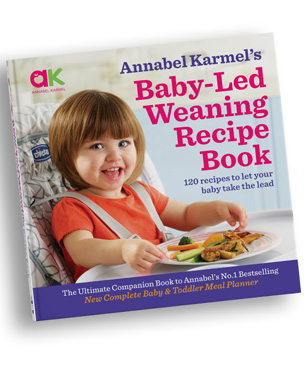 If you’re thinking of incorporating baby-led weaning into your baby’s routine, leading children’s cookery author Annabel Karmel shares her tips for getting started.
If you’re thinking of incorporating baby-led weaning into your baby’s routine, leading children’s cookery author Annabel Karmel shares her tips for getting started.
- Ensure you have a safe place for your baby to sit – she should be able to sit upright unassisted.
- It’s really important to take your baby’s lead. Finger foods such as steamed carrot batons, roasted sweet potato and chopped up pieces of fruit such as banana and avocado are a good place to start. My top tip is to feed your baby solids once a day to start out with, gradually increasing quantities as she shows she wants more. Once she is comfortable with finger foods there is no reason why you can’t also serve a portion of what you are eating as a family – a mild curry, cottage pie or steamed fish with roasted veggies are all fine to offer to your baby. Just be sure to leave out the salt.
- Baby-led weaning is all about making mealtimes a sociable experience. Whilst not all families have the luxury of sitting round the table together every night, there are still ways to ensure your baby is involved. Even if you sit down and have a small snack with your baby (or a small piece of what they are eating), it will transform mealtimes into a fun sociable experience for them. It’s also amazing how a little bit of encouragement can make all the difference!
- Baby’s first finger foods at six months should be soft and easy to swallow. It’s all about making sure that she is getting the right amount of healthy foods with a good balance of nutrients. Look to include a good mix of fresh fruits, soft, cooked vegetables, healthy carbohydrates and fats.
Here are some of my top Baby-Led Weaning first foods to get started with:
- Cooked batons of carrot, sweet potato and broccoli (I would suggest cutting food into 5–6cm batons or sticks so that half is held in a baby’s hand and the other half sticks out.)
- Thick chunks of mango, banana, avocado, peaches and strawberries
- Cheese, cut into sticks or chunks
- Unsalted rice cakes or bread sticks
- Cubes or fingers of bread, toast or pitta bread
- Soft pasteurised cheeses cut into chunks
- Cooked eggs, cut in half
- Pieces of cooked fish (just be careful to check for any bones)
- Cooked chicken pieces (the dark meat is the most nutritious)
It’s also important to be aware of the foods which your baby shouldn’t eat under the age of 12 months. Find out more here.
Safety Concerns
Choking is a question I get asked about all the time and it’s understandable that parents worry about this. I think my main piece of advice would be to follow your baby’s lead – their own developmental abilities are what ensure that the transition to solid foods takes place at the right time for her. For example, a baby who is struggling to get food into her mouth probably isn’t quite ready and so it would be advisable to stick with purees for a bit longer and then when they are ready slowly start to introduce soft finger foods. Going at your baby’s own pace will significantly reduce the risk of choking.
It’s also worthwhile understanding the difference between choking and gagging as often the two can get confused and panic ensues! Gagging is your baby’s own safety mechanism that prevents choking by pushing food away from the airway if it is too big to be swallowed. The gag reflex in babies is triggered towards the front of the tongue (unlike adults where this is much further back). That’s why finger foods are great from 6 months as your baby learns to chew and swallow when this reflex is safely close to the front of the mouth.
It’s important to note that however your baby is fed, they shouldn’t be left alone while eating, and they must always be supported in an upright position.
Avoid these foods that could cause choking
- Whole grapes
- Whole cherry tomatoes
- Whole or chopped Nuts
- Fruits with stones such as cherries
- Bony fish (always check thoroughly for bones first)
Remember that babies have a tendency to store food in their mouth for some time so just check they’re not storing any spare food reserves.
Whatever weaning method you decide to adopt, whether it’s spoon-led, baby-led or a mixture of the two, it’s all about being flexible in your approach and doing what’s right for you and your baby. If you provide her with a variety of nutrient-packed purees at the very beginning, along with soft finger foods and nutritious family meals that she can experiment with herself then you can’t go far wrong.
Happy weaning!
Annabel Karmel’s brand new Baby- Led Weaning Recipe Book (out on 25th May) gives you the tools and inspiration to incorporate baby-led weaning into your baby’s routine. It can be used on its own for exclusive baby-led weaning. Or, it can be used as a companion cookbook to Annabel’s original feeding guide, the New Complete Baby & Toddler Meal Planner, which is filled with her popular puree recipes.
As well as being packed with useful advice and top tips, the book is filled with 120 recipes which the whole family can enjoy together – from breakfast and snacks, to vegetables, poultry, fish, meat and more. Visit www.annabelkarmel.com for more information.

